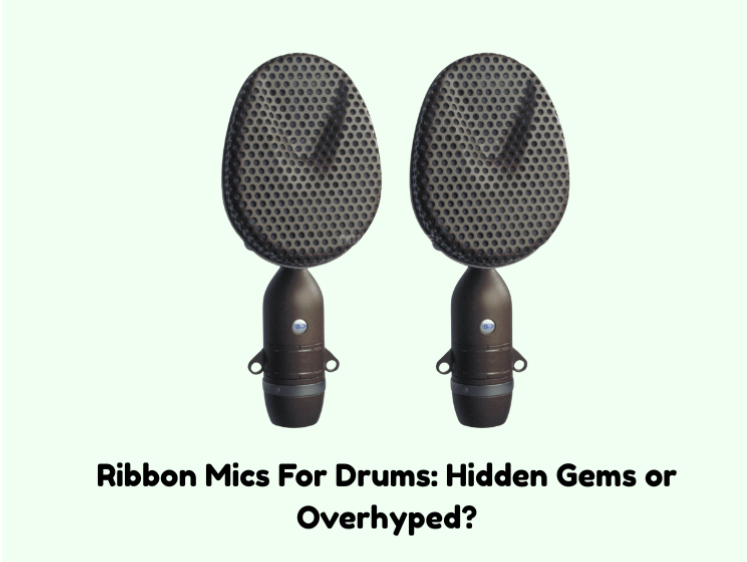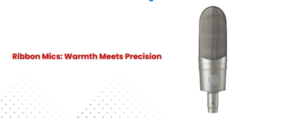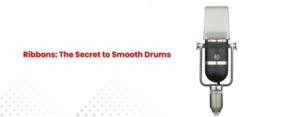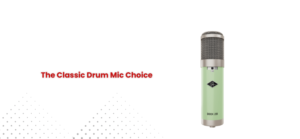Ribbon microphones aren’t usually used to record drums. Most engineers choose dynamic mics for durability or condensers for their high, detailed response. But for the past few years, ribbon mics have developed a cult following thanks to their warm, natural sound. Some say they’re a secret weapon for recording drums, while others insist they’re impractical and overhyped. So, are ribbon mics worth it on drums? Let’s find out.
Why Use Ribbon Mics for Drums?
Ribbon mics also have a distinct method of sound pickup. In contrast to condensers that accentuate brightness and attack, ribbons will smooth out edgy transients and lend a more natural sound. This gives them a particular appeal for drum overheads, room mics, and even some close-miking situations.
Overheads:
One of the greatest strengths of ribbon mics is cymbals. When it comes to cymbals, it’s often a good idea to use ribbons because ribbons roll off the top end, as opposed to brighter condensers that make cymbals sound harsh when recorded—this creates a smooth-sounding, more balanced tone when recording with ribbons. This is especially beneficial in jazz or vintage-style recordings where a more natural, unprocessed sound is desired. Ribbon mics are so nice to use as overheads that many engineers are addicted to them when capturing the whole kit, which is a little more tasty than bright and in your face.
Room Mics:
Because of their sonic character and the distance crunchy sounds they can produce, ribbon mics also excel as room mics. Their figure-8 polar pattern picks up sound in front of and behind a microphone but rejects noise from the sides, allowing them to capture some of the recording space’s natural ambience. It can imbue a drum mix with greater depth and realism. A pair of well-placed ribbon room mics in good-sounding but not necessarily large rooms can make a drum kit sound bigger and more present than it is naturally without abusing or overusing reverb or post-processing.
Close-Miking:
Though not a particularly common close-miking option, some engineers have fun experimenting with ribbons on snares and toms, floor toms especially. For example, the Beyerdynamic M160 is a hyper-cardioid ribbon mic that surprisingly excels in close drum applications. It documents a thick, warm tone with none of the clanky brilliance of a condenser or the cardboardiness of some dynamic mics.
Things to Watch Out for With Ribbon Mics on Drums
As useful as they are, ribbon mics aren’t a one-size-fits-all solution.
Fragility:
The major issue is their fragility. Normal ribbon microphones have fragile elements that are susceptible to injury from high air pressure—the type that drums inherently create a lot of. The quality of sound that can be expected from a ribbon mic is certainly not diminished, but they can be blown easily by close-miked snares or kick drums—powerful blasts of air from a snare can fry a ribbon mic—and tend to be a poor choice for hard-hitting styles.
Low Output:
Their low output is another problem. Ribbon mics usually need more gain compared to dynamics or condensers, so you want a good preamp to keep noise at bay. If your audio interface or mixer doesn’t give you enough clean gain, you may need an inline booster like a Cloudlifter to crank the signal up to a usable level.
Genre Limitations:
Besides technical limitations, ribbon mics might not work for all musical genres. If you’re recording rock, metal, or other adrenaline-infused genres that thrive on sharp attack and bright cymbals, ribbons might not provide the clarity you desire. Their smooth sound lends itself well to vintage-style recordings, though it sometimes lacks the punch and definition needed in modern productions. That’s not to say that ribbon mics can’t find a home in these genres, but they may need extra mixing tricks to deliver what’s needed in attack.
Best Ribbon Mics for Drums
If ribbon mics are on your list for your next round of drum recording, it’s important to pick the right ones.
- Royer R-121 – A warmer but more detailed-sounding ribbon microphone. To capture the full characteristics of the kit, it is often used as an overhead or room mic.
- Coles 4038 – A ribbon mic that’s prized for its natural vintage tone. This mic has long been a staple in professional studios, and it delivers when it comes to capturing a smooth, natural drum sound.
- Royer R-10 – A more affordable entry-level ribbon mic that has most of the characteristics of the larger, higher-end mics.
- Beyerdynamic M160 – One of the few ribbon mics that manages well when close-miking drums without receiving excessive bleed from other kit parts, thanks to its hyper-cardioid polar pattern.
Using Ribbon Mics for Drums: Do They Have a Place?
So, are ribbon mics a hidden gem, or are they absolutely overhyped when it comes to recording drum kits?
The answer depends on what you need. Those who want a more natural, warm drum sound that has a smooth, high-end should consider ribbon mics. They double as overheads and room mics with great success, helping to add body and realness to your drum sound. For jazz and blues and vintage-inspired music, they can be a game-changer.
If you’re after a bright, punchy, and modern drum sound, then ribbon mics probably aren’t the best option for you. They have a balanced character that can be either sweet or rich, depending on the interconnects used, the preamp they are paired with, and the recording environment. They’re not the most versatile option in every context, but in the right hands, they can provide a unique quality that other mics can’t quite match.
In the end, ribbon mics aren’t overhyped—they just need to be used in the right way. They can be a great addition to your drum miking setup when approached with the understanding of the strengths and limitations.




